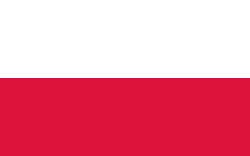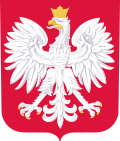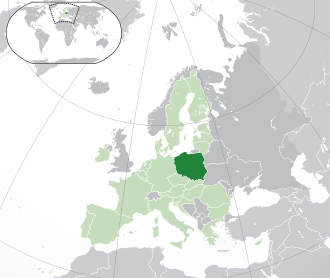
Back Польша Abkhazian Polandia ACE Полшэ ADY Pole Afrikaans Polen GSW ፖላንድ Amharic Poland AMI Polonia AN Polaland ANG Polan ANN
Republic of Poland Rzeczpospolita Polska (Polish) | |
|---|---|
| Anthem: "Mazurek Dąbrowskiego" ("Poland Is Not Yet Lost") | |
Location of Poland (dark green) – in Europe (green & dark grey) | |
| Capital and largest city | Warsaw 52°13′N 21°02′E / 52.217°N 21.033°E |
| Official language | Polish[1] |
| Ethnic groups (2021)[2] |
|
| Religion (2021[3]) |
|
| Demonym(s) |
|
| Government | Unitary semi-presidential republic[8] |
| Andrzej Duda | |
| Donald Tusk | |
| Legislature | Parliament |
| Senate | |
| Sejm | |
| Formation | |
| c. 960 | |
| 14 April 966 | |
| 18 April 1025 | |
| 1 July 1569 | |
| 11 November 1918 | |
| 17 September 1939 | |
| 22 July 1944 | |
| 31 December 1989[10] | |
| Area | |
• Total | 312,696 km2 (120,733 sq mi)[12][13] (69th) |
• Water (%) | 1.48 (2015)[11] |
| Population | |
• 2022 census | |
• Density | 122/km2 (316.0/sq mi) (75th) |
| GDP (PPP) | 2025 estimate |
• Total | |
• Per capita | |
| GDP (nominal) | 2025 estimate |
• Total | |
• Per capita | |
| Gini (2022) | low inequality |
| HDI (2023) | very high (35th) |
| Currency | Złoty (PLN) |
| Time zone | UTC+1 (CET) |
• Summer (DST) | UTC+2 (CEST) |
| Date format | dd.mm.yyyy (CE) |
| Calling code | +48 |
| ISO 3166 code | PL |
| Internet TLD | .pl |
| |
Poland,[d] officially the Republic of Poland,[e] is a country in Central Europe. It extends from the Baltic Sea in the north to the Sudetes and Carpathian Mountains in the south, bordered by Lithuania and Russia[f] to the northeast, Belarus and Ukraine to the east, Slovakia and the Czech Republic to the south, and Germany to the west. The territory has a varied landscape, diverse ecosystems, and a temperate climate. Poland is composed of sixteen voivodeships and is the fifth most populous member state of the European Union (EU), with over 38 million people, and the fifth largest EU country by land area, covering 312,696 km2 (120,733 sq mi). The capital and largest city is Warsaw; other major cities include Kraków, Wrocław, Łódź, Poznań, and Gdańsk.
Prehistoric human activity on Polish soil dates to the Lower Paleolithic, with continuous settlement since the end of the Last Glacial Period. Culturally diverse throughout late antiquity, in the early medieval period the region became inhabited by the West Slavic tribal Polans, who gave Poland its name. The process of establishing statehood coincided with the conversion of a pagan ruler of the Polans to Christianity in 966 under the auspices of the Roman Catholic Church. In 1025, the Kingdom of Poland emerged, and in 1569 it cemented its long-standing association with Lithuania, forming the Polish–Lithuanian Commonwealth. At the time, the Commonwealth was one of Europe's great powers, with an elective monarchy and a uniquely liberal political system. It adopted Europe's first modern constitution in 1791.
With the passing of the prosperous Polish Golden Age, the country was partitioned by neighbouring states at the end of the 18th century. At the end of World War I in 1918, Poland regained its independence with the founding of the Second Polish Republic, which emerged victorious in various conflicts of the interbellum period. In September 1939, the invasion of Poland by Germany and the Soviet Union marked the beginning of World War II, which resulted in the Holocaust and millions of Polish casualties. Forced into the Eastern Bloc in the global Cold War, the Polish People's Republic was a signatory of the Warsaw Pact. Through the 1980 emergence and contributions of the Solidarity movement, which initiated the fall of the Iron Curtain, the communist government was dissolved and Poland re-established itself as a liberal democracy in 1989, as the first of its neighbours.
Poland is a semi-presidential republic with its bicameral legislature comprising the Sejm and the Senate. Considered a middle power, it is a developed market and high-income economy that is the sixth largest in the EU by nominal GDP and the fifth largest by PPP-adjusted GDP. Poland enjoys a very high standard of living, safety, and economic freedom, as well as free university education and universal health care. It has 17 UNESCO World Heritage Sites, 15 of which are cultural. Poland is a founding member state of the United Nations and a member of the Council of Europe, World Trade Organisation, OECD, NATO, and the European Union (including the Schengen Area).
- ^ Constitution of the Republic of Poland, Article 27.
- ^ "National Population and Housing Census 2021 Population. Size and demographic-social structure in the light of the 2021 Census results".
- ^ "Final results of the National Population and Housing Census 2021". Statistics Poland.
- ^ Veser, Ernst [in German] (23 September 1997). "Semi-Presidentialism-Duverger's Concept — A New Political System Model" (PDF). Department of Education, School of Education, University of Cologne, zh. pp. 39–60. Retrieved 21 August 2017.
Duhamel has developed the approach further: He stresses that the French construction does not correspond to either parliamentary or the presidential form of government, and then develops the distinction of 'système politique' and 'régime constitutionnel'. While the former comprises the exercise of power that results from the dominant institutional practice, the latter is the totality of the rules for the dominant institutional practice of power. In this way, France appears as 'presidentialist system' endowed with a 'semi-presidential regime' (1983: 587). By this standard, he recognizes Duverger's pléiade as semi-presidential regimes, as well as Poland, Romania, Bulgaria and Lithuania (1993: 87).
- ^ Shugart, Matthew Søberg (September 2005). "Semi-Presidential Systems: Dual Executive and Mixed Authority Patterns" (PDF). Graduate School of International Relations and Pacific Studies. Archived from the original (PDF) on 19 August 2008. Retrieved 21 August 2017.
- ^ Shugart, Matthew Søberg (December 2005). "Semi-Presidential Systems: Dual Executive And Mixed Authority Patterns" (PDF). French Politics. 3 (3): 323–351. doi:10.1057/palgrave.fp.8200087. Retrieved 21 August 2017.
Even if the president has no discretion in the forming of cabinets or the right to dissolve parliament, his or her constitutional authority can be regarded as 'quite considerable' in Duverger's sense if cabinet legislation approved in parliament can be blocked by the people's elected agent. Such powers are especially relevant if an extraordinary majority is required to override a veto, as in Mongolia, Poland, and Senegal. In these cases, while the government is fully accountable to Parliament, it cannot legislate without taking the potentially different policy preferences of the president into account.
- ^ McMenamin, Iain. "Semi-Presidentialism and Democratisation in Poland" (PDF). School of Law and Government, Dublin City University. Archived from the original (PDF) on 12 February 2012. Retrieved 11 December 2017.
- ^ [4][5][6][7]
- ^ a b "Poland". Encyclopedia Britannica. 2023. Archived from the original on 19 January 2024. Retrieved 31 December 2023.
- ^ "The Act of December 29, 1989 amending the Constitution of the Polish People's Republic". Internetowy System Aktów Prawnych. Archived from the original on 19 October 2020. Retrieved 18 October 2020. (in Polish)
- ^ "Surface water and surface water change". Organisation for Economic Co-operation and Development (OECD). Archived from the original on 24 March 2021. Retrieved 11 October 2020.
- ^ GUS. "Powierzchnia i ludność w przekroju terytorialnym w 2023 roku". Archived from the original on 22 September 2023. Retrieved 19 October 2023.
- ^ "Poland country profile". BBC News. 12 November 2023. Archived from the original on 21 October 2023. Retrieved 12 November 2023.
- ^ "Statistical Bulletin No 11/2022". Statistics Poland. Archived from the original on 23 December 2022. Retrieved 23 December 2022.
- ^ "World Economic Outlook Database, April 2025 Edition. (Poland)". International Monetary Fund. April 2025. Retrieved 27 April 2025.
- ^ "World Economic Outlook Database, April 2025".
- ^ "World Economic Outlook Database, April 2025".
- ^ "World Economic Outlook Database, April 2025".
- ^ "Gini coefficient of equivalised disposable income – EU-SILC survey". ec.europa.eu. Eurostat. Retrieved 13 April 2024.
- ^ "Human Development Report 2025" (PDF). United Nations Development Programme. 6 May 2025. Archived (PDF) from the original on 6 May 2025. Retrieved 6 May 2025.
Cite error: There are <ref group=lower-alpha> tags or {{efn}} templates on this page, but the references will not show without a {{reflist|group=lower-alpha}} template or {{notelist}} template (see the help page).



